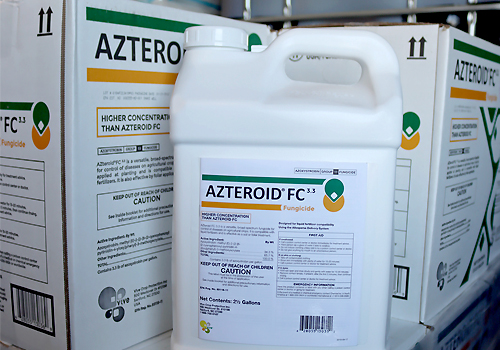Vive Crop Protection and the A&S alumni behind the company are using an innovative technology they developed at the Department of Chemistry in the Faculty of Arts & Science to rewrite the book on efficient, sustainable and cost-effective pesticides and fertilizers.
Darren Anderson, CEO and co-founder of Vive, knew little about agriculture when he began the Mississauga-based AgTech startup. He was a doctoral student in chemistry with no entrepreneurial experience beyond a tutoring business he ran years earlier.
“You have an interesting combination of arrogance and humility coming out of an advanced degree,” says Anderson, who earned his honours bachelor of science in 2001 as a member of University College before pursuing his master’s and doctorate.

“You've got the confidence of being early in your career and knowing you're going to go out there and have a huge impact on the world. You need that confidence because entrepreneurship is about willing the future into existence.”
Anderson and his co-founder Jordan Dinglasan have done just that. Vive has been growing as rapidly as the crops benefitting from its products, building trust in the industry, expanding product offerings and growing operations in the United States and Canada.
“Seeing the products we developed being used by real customers, getting to meet customers and see the impact our products have on their lives is really rewarding and hard to express in words,” says Dinglasan, who earned his master’s degree in 2001 and PhD in 2005.
Dinglasan leads the charge on the technical side of Vive. He is the driving force behind their signature “Allosperse” technology, which is a delivery system that uses "shuttles" made of their patented polymers (substances composed of very large molecules) to carry an active ingredient where it needs to go. Because these polymers are highly adaptable, the team at Vive can tailor each product to the grower’s needs.
Allosperse also enables another crucial part of the Vive team’s efforts: promoting sustainability. The effectiveness of the delivery system means less product is used to achieve better results, reduced runoff, less water consumption, improved soil quality and more. The company has received more than a dozen clean tech awards for its efforts.

Last year, Vive was named a Deloitte Technology Fast 500 winner and selected as one of eight in the inaugural cohort of Canada’s Global Hypergrowth Project, which grants the company funding support from the government as well as a host of other perks.
“I didn't appreciate when we started working in agriculture just how critical technology is and how thirsty growers are for new tools and new opportunities to help them be more effective,” Anderson says. “If you get a grower excited about what you're doing, you're going to have a customer for life.”
But farmers’ product loyalty goes both ways and, especially in the early years of Vive, it was not always easy to convince a farmer to stake an entire year of large row crops on an experiment.
“The credibility we've built with sugar beet growers in Minnesota does not translate to cotton growers in Texas,” Anderson says.
When Vive was little more than a fledgling startup, Anderson and Dinglasan enlisted the help of yet another A&S alum, Keith Thomas. Thomas brought the entrepreneurial experience the pair needed, as well as investors and funding of his own. He took Anderson under his wing and helped guide the company toward profitability.
“Keith is very good from an externally facing, investor facing perspective,” Anderson says. “I think I bring a little bit more of that technology mindset.”
“There's a 13-year age gap between Darren and me, but I would say when we're working together, we're very much work spouses,” says Thomas, who earned a master’s degree in economics in 1989. “He's a really good partner.”
Thomas was the CEO of Vive until 2019, when he stepped down in a planned transition to hand leadership of the company back to Anderson. He is still closely involved in the company, currently as its director.
“Darren was ready to take the reins,” Thomas says. “If people stick on too long beyond their past due date, it's not good for anybody. Not good for the company. Not good for themselves.”
While Thomas’s early support and Anderson’s passion were both fundamental to Vive’s success, it is the Allosperse technology that makes the company singular. Dinglasan began developing the nanoparticle technology behind Allosperse while he and Anderson were working in Professor Cynthia Goh’s lab.

Using a phenomenon called polyelectrolyte collapse, which creates small polymer vessels with special properties, Dinglasan and his peers in Goh’s lab found they could create “empty” polymers with water-repellant cores. These polymers, which range from between ten and 1,000 nanometers in diameter (roughly between the size of a strand of DNA and a bacterium), turned out to be perfect vessels for hydrophobic pesticides. They discovered they could tune how their nanoparticles delivered the pesticide to the target by modifying the surfaces of the particles. This technology became the fundamental process behind Allosperse.
“We developed a versatile platform that was simple, scalable and low cost,” Dinglasan says.
Goh’s tutelage was not just critical for developing the chemistry that now underpins Vive. Under her mentorship, Anderson and Dinglasan brainstormed applications for their nanoparticle technology and developed the entrepreneurial know-how to get Vive off the ground. Both Anderson and Dinglasan credit Goh as a catalyst for their success.
“The training we received during graduate school at U of T was key to getting me to where I am now,” Dinglasan says.
Goh is a pioneer when it comes to encouraging graduate students — especially those in the physical sciences — to consider careers outside academia, in industry. Her seminar series, which has since evolved into the Entrepreneurship 100 masterclass at MaRS, gave Anderson, Dinglasan and others like them the confidence and expertise to turn their knowledge into action.
“I believe strongly in bringing science to society by making it work for the world,” Goh says. “Vive is a validation of the view I have of how to build scientist-entrepreneurs.”
Vive and Goh’s lab maintain a close connection, both through the collaborative research that keeps Goh and her students studying the mechanics of the nanoparticles that are the core technology behind Allosperse and through the interpersonal connections that have persisted through the years.
Eighteen years after Anderson finished his PhD, he and Goh still meet for lunch to compare notes on business and chemistry.
"From my perspective, nothing has changed,” Goh says. “It's the same relationship I had with them when they were students because I don't really treat my students as juniors. We're a team.”
These days, Anderson is committed to his role of CEO, piloting the external side of the company, while Dinglasan oversees the science — the same division of labour the pair have had since their days at U of T.
It’s a busy time. Vive just achieved another milestone, releasing its first Canadian product after years spent navigating regulatory red tape. For a company sprung from U of T and based out of Mississauga, delivering products in Canada was always a must for the team. The product, AZteroid FC 3.3, is geared toward a potato fungus problem faced by Canadian farmers.
It sold out just weeks after its release.
For Anderson, Dinglasan, Thomas and their team at Vive, the sky is the limit.
“Any good entrepreneur, their eyes are bigger than their stomachs,” Anderson says. “But we have very large forks.”

